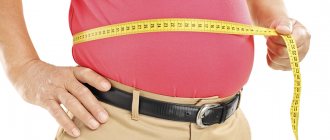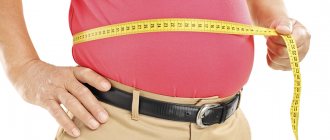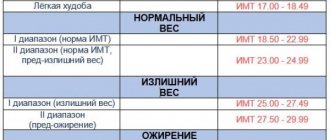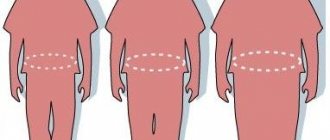Waist-hip ratio (English abbreviation WHR, which can be translated as THR - waist-hip ratio) is the ratio of the circumference at the waist to the circumference at the hips.
There is actually no such generally accepted abbreviation as TBS
This indicator is very popular in the West, where a lot of research has been conducted on its effect on attractiveness, as well as as an indicator of health.
How to measure your waist and hip circumference correctly
There are rules developed by different organizations to make these measurements correctly. While everything is simple with hips, when measuring the waist, different organizations use slightly different measurement standards.
Measuring the hips and waist: for a thin person (left), the waist should be measured correctly at the narrowest point, while for a fuller person (right) it should be measured approximately 2 cm above the navel. The hips are measured at their widest part, regardless of the figure (approximately in the middle).
Waist and hip measurement rules used by world-famous organizations
According to the World Health Organization (WHO) protocol, waist circumference should be measured midway between the lower edge of the lower rib and the top of the iliac crest (the upper pelvic bone, seen from the side). A measuring tape is used for this (colloquially “centimeter”). When tightened, it should create a pressure equivalent to 100 grams. Hip circumference should be measured around the widest part of the buttocks, using the same tape, parallel to the floor.
The US National Institutes of Health and the National Nutrition Examination Program use results obtained by measuring at the top of the iliac crest—essentially where we typically have the waistband of standard pants.
Often, non-professionals measure the waist at the level of the navel, but studies have shown that this method can often result in an understatement of its actual circumference.
When measuring both circumferences, the person should have their feet side by side, arms apart, body weight evenly distributed, and no excess clothing. Breathing should be normal, calm, and measurements should be taken at the end of exhalation. Each measurement is repeated twice, and if there is a centimeter difference between them, then the average results are taken.
The easiest way to measure your waist and hips correctly
In practice, in order not to delve into all these subtleties, the waist with a slender figure is most correctly measured simply in the area of its smallest circumference, as a rule, slightly above the navel. In cases where the waist is convex rather than concave, for example, as happens during pregnancy or when you are overweight, the location of the smallest circumference is often more difficult to determine. In such cases, to determine the degree of obesity, a measurement is taken a couple of centimeters above the navel. Hip circumference can be measured simply visually at the widest part of the buttocks.
Do not forget that these are the rules for taking measurements to determine the degree of obesity and other health indicators, and not for sewing or selecting clothes.
Is it normal if the waist is 80 cm?
In the modern world, different countries have their own beauty standards. However, large weight and volume are rarely considered beautiful, as they most often talk about obesity. At the same time, obese people most often suffer from various pathologies.
A person’s large belly automatically makes him a candidate at risk for diseases associated with metabolic disorders. This type of obesity, when a woman’s waist is more than 80 cm, and a man’s is more than 94 cm, is called abdominal obesity. At the same time, a person most often has relatively thin arms and legs, and the stomach even visually stands out from the body.
Principles of waist measurement at home
Those who have assessed their figure in the mirror and decided that it is necessary to measure their waist should know how to do this correctly. It is necessary to measure not the narrowest place, but place the centimeter along the next circle. On the sides the line runs above the iliac bone tuberosities, and in front below the edge of the costal arches.
Maximum waist values of 80 and 94 centimeters are typical for Europeans. For Americans, these figures are 88 cm and 109 cm. And in Asia, a woman’s waist should not exceed 79 cm, and a man’s 86 cm.
Of course, it is better for us to focus on the indicators of Europeans, since a significant part of the population belongs to the Caucasian race.
And if Americans believe that a woman’s waist of 80 cm is normal, you should not focus on these parameters, since in the USA there are more and more obese people and the number of endocrine diseases there is increasing every year.
Waist to hip ratio in a healthy person
Waist-to-hip ratio is used as an indicator and measure of a person's health. Using this coefficient, you can see the degree of risk of developing serious diseases. Research shows that people with an apple body shape (waist wider than the hips) face greater health risks than those with a pear body shape, whose hips are wider than the waist.
This ratio is also used to determine obesity, which in turn serves as an indicator of other more serious diseases.
WHO states that abdominal obesity occurs when a waist-to-hip ratio is greater than 0.90 for men and 0.85 for women, or a body mass index (BMI) greater than 30.0. According to the National Institute of Diabetes and Digestive and Kidney Diseases (NIDDK), women who have a THR greater than 0.8 and men who have it greater than 1.0 are at increased health risk.
HBS is a better predictor of life expectancy in older people than waist circumference or BMI (body mass index). But if obesity is determined by this indicator, instead of BMI, then the number of people in the world who are at increased risk of a heart attack will decrease by three times. Waist-to-hip ratio is considered to more accurately indicate the percentage of body fat relative to body weight than waist circumference or BMI. Of these three values, only TBS takes into account differences in body structure (muscle mass, bone width, fat). Thus, it is possible for two women to have completely different weights but the same waist-to-hip ratio, or to have the same BMI but completely different waist-to-hip ratios.
Even in ancient civilizations around the world, ideal women were most often represented with a TBC in the range of 0.6-0.7. Simply put, a woman who had much wider hips than her waist was considered more beautiful. Most likely, this is explained by the subconscious understanding of men that a woman with wide hips is more predisposed to having children. But more about this later in the article.
According to some studies, WBS is a better predictor of your chances of developing cardiovascular disease than waist circumference and body mass index. But others show that waist circumference is a more accurate indicator of cardiovascular risk factors, body fat distribution and hypertension in people with type 2 diabetes. Therefore, it is impossible to say for sure which of these indicators can tell more about health.
Why could this be dangerous?
Abdominal obesity has long been known as a risk factor for heart attack. But relatively recently, the European Journal of Preventative Cardiology published conclusions drawn after a long study. The scientists who conducted this study claim that excess belly fat very often causes recurrent strokes and heart attacks.
Moreover, these doctors claim that if you have abdominal fat, it does not matter how much and what kind of heart attack medications you take, the risk of recurrence of the disease will remain until you manage to lose weight.
The studies were conducted over four years and involved more than 22 thousand patients who had already suffered a myocardial infarction in the past. As a result, it was proven that a large waist is an independent factor in the occurrence of secondary infarction. It stands alongside factors such as hypertension, diabetes, smoking and the like.
Degrees of obesity in men and women
Waist and hip volume as an indicator of reproduction
A THR of 0.7 for women and 0.9 for men has been shown to be closely associated with overall health and the ability to give birth or conceive a child. Women with a TPS of around 0.7 have optimal estrogen levels and are less susceptible to underlying diseases such as diabetes, cardiovascular disease and ovarian cancer. Women with a high waist-to-hip ratio (0.80 or higher) have a significantly lower chance of becoming pregnant than those with a WHR of 0.70-0.79, regardless of their BMI. Men with a TPS of around 0.9 similarly have a better chance of conceiving and are also less likely to get prostate and testicular cancer.
Research shows that the ratio of waist to hip length is an accurate indicator of reproductive health, in terms of the body's production of the necessary hormones for this. Among girls with the same weight, with lower TBS rates, puberty occurs earlier. This is manifested in the growth of luteinizing hormone (LH) and follicle-stimulating hormone (FSH), as well as the sex steroid hormone - estradiol.
A Dutch prospective (with a selected group of people) study of artificial insemination confirmed an increase in the chances of getting pregnant with low TBS back in 1993. It showed that with an increase of 0.1 unit of hip joint, it reduces the likelihood of conception in a cycle by 30%. This is adjusted for age, weight, reasons for artificial insemination, length and regularity of cycles, and smoking.
Excess fat around the waist: harmful to health
Excess fat tissue around the waist, around important internal organs, is abdominal fat. If the fat tissue ratio is normal, then this will not cause any complications, but excess fat is already toxic to all body systems.
It’s also bad when there is a lack of fat mass, because then little estrogen (sex hormones) is synthesized. But obesity poses even more problems. There is a disruption in the metabolic function of adipose tissue and then various inflammatory molecules appear, destroying the normal metabolic process in all systems of the body.
The influence of mother's waist and hip size on child's cognitive abilities
American scientists even studied the relationship between the cognitive abilities (roughly speaking, thinking) of young children and the waist-to-hip ratio of their mothers (WHR). As a result of the tests, it was found that children whose mothers had wider hips and smaller hip joints were more mentally developed. This is explained by the fact that the fetus received additional long-chain polyunsaturated acids from the fat on the mother's thighs. In addition, statistics also show that children of girls with low TBS who became mothers in adolescence were more protected from cognitive impairment associated with having a child at too young an age.
What determines the size of the waist and hips
Twin studies have shown that 22-61% of waist-to-hip ratios can be explained by genetic factors. Among other factors, nutrition and lifestyle occupy the first places.
Formula for a beautiful waist
Probably every woman dreams of a beautiful waist, but the canons of beauty are a rather subjective concept. Note that there are a decent number of opinions and various indicators indicating the optimal waist value. So, for example, the model ratio talks about the parameters 90-60-90. But approaching such numbers may indicate anorexia.
Some experts believe that the optimal indicator of a woman's waist circumference is height divided in half. Fifteen still needs to be subtracted from this value. For example, if a girl is 170 centimeters tall, her ideal waist size will be 70 centimeters. This is the formula for a beautiful waist.
Ideal waist to hip ratio
Some researchers have found that waist-to-hip ratio (WHR) is an important measure of female attractiveness. Women with a TBI of 0.7 tend to be rated as more attractive by men from Indo-European cultures. Tastes can vary, according to some studies, from 0.6 (in China, South America, and parts of Africa) to 0.8 (in Cameroon and the Hazda tribe of Tanzania), with diverging preferences depending on ethnicity.
It seems that men pay more attention to a woman's waist size than her hip size. The Journal of Biological Psychology had this to say about this:
“The size of your hips and waist indicates the amount of extra fat that can be used as an energy source. The waist conveys information such as current reproductive status or health conditions... in Western countries where there are no seasonal food shortages, the waist, conveying information about fertility and health status, will be more important than hip size in assessing female attractiveness."
In less wealthy and developed countries, women have a higher number of pregnancies, health burdens from parasites, and consume less high-calorie food. In this regard, women with a higher TBC are often considered more attractive there. This also affects the difference in the age at which marriageable age and peak birth rates fall in such countries.
Thus, the size of the hip joint, which indicates the onset of puberty, sexuality, reproduction, hormonal disorders and distinguishes a man from a woman, differs in different populations.
Waist more than 80 centimeters for women: how to lose weight?
After discovering that they are overweight, many begin to think that it’s okay, I’ll soon start playing sports and lose weight. However, “soon” is a loose concept, and is often postponed until later. So, if your female waist is already more than 80 centimeters, then you should urgently put it in order.
- Start with exercise. Don’t be afraid to tax yourself with walking, dancing, swimming - it will definitely be beneficial.
- For greater confidence, so as not to harm women’s health, go to the clinic to see a doctor for exercise therapy. It is he who will be able to choose strength, dynamic physical training for you with the correct selection of the pulse zone. This way you can lose fat mass and gain muscle mass. Everything should be adjusted perfectly; your body does not need too much stress.
- It is very important to give up baked, fried, fast food, smoked foods and other junk foods. Nutrition must be correct, and strictly control your food intake. It is very useful to include vegetables, herbs, protein, and a small amount of fatty oils in your food.
- Find an experienced endocrinologist and nutritionist and try to follow all their recommendations. If you follow your daily routine and diet, this will give a quick effect that you will feel soon.
- In severe cases, doctors may recommend surgery to reduce the patient's appetite. The surgeon will reduce the volume of the stomach, thereby allowing a person to lose weight, because he will be satisfied with food faster.
How to reduce your waist
All the work does not come down to reducing the patient’s body weight, more precisely, this too, but first of all, doctors care about the person’s health. Thanks to weight changes, constant physical activity, and nutritional rules, a person will regain health. The process will delay the manifestation of all sorts of diseases, due to which mortality is now increasing even among middle-aged people.
If you are interested, you can also look at these articles:
- Diet table No. 6 to improve the condition of the genitourinary system
- How to give insulin injections correctly?
- LPG massage, for weight loss, against cellulite
- Diet No. 1 after surgery
- Fractional meals for weight loss
The influence of waist-to-hip ratio on attractiveness (research results)
The concept and meaning of TBS as an indicator of attractiveness was first described in 1993 by an American psychologist named Devendra Singh. He argued that this ratio is a more consistent measure of estrogen than the bust-waist ratio (BWR).
In a series of studies conducted by Singh (1993), participating men used a woman's HB and body fat distribution to determine her attractiveness. The men were shown a series of 12 drawings of women with different HB scores and the distribution of fat in their body. Women in the drawings with normal fat distribution and moderate TBS were associated with the most positive traits (i.e., sexy, smart, and healthy). When considering the depicted women with low TBS (small difference between the waist and hips), other than youth, men did not associate them with anything positive.
In this study, Singh suggested that men and women may have developed innate mechanisms that detect and use waist-to-hip ratio to assess how healthy a person is. Having a certain waist-to-hip ratio increases the chances of getting healthy offspring with hereditary genetic protection against various diseases.
Other studies have found that TJ is a sign of attractiveness that goes beyond just fat and fertility. For example, a study was conducted using eye tracking techniques on men while they digitally manipulated the same woman. In addition to eye tracking, subjects were also asked to rate the image based on attractiveness. Although men fixed their eyes during the study mainly on women's breasts, regardless of its size, they called the most attractive a woman with a TBC of 0.7.
In addition, a study was conducted by Joson and Tazinari in 2005. The reaction to an animated human walking was considered. It turns out that men not only use TBS to evaluate attractiveness, but also as a means to determine sexual differences. At the same time, a person with a higher waist-to-hip ratio is perceived as more masculine. And with a lower value, when the hips are not so noticeably wider than the waist, the object seems more feminine and gentle. The authors of this study suggest that this provides an additional explanation for why men perceive lower TBI as more attractive. It was also concluded that for this reason, men who have a smaller hip joint feel less confident and independent than men with a higher and more courageous hip joint.
To increase attractiveness, some women artificially change their waist-to-hip ratio. These methods include using a corset to reduce the size of the waist and visually increase the apparent size of the hips and buttocks. During various such attempts during the 20th century, manufacturers used sizing calculations called hipspring, which translated means “spring hips” or “spring hips,” to make corsets. In this case, the height of the part of the corset for tightening the waist was calculated by subtracting the waist size from the hip size. However, this method of calculating sizes fell out of use because it often gave a poor indicator of attractiveness. For example, a size 10 inches (250 mm height of the corset) will look very attractive on an adult woman with average parameters, but a child or small woman with a corset of this size will look like an undernourished person.
In the case of TBS, the brain evaluates the level of attractiveness based on the ability to reproduce offspring (reproductivity), and on the presence of fat in the body. This was confirmed by one interesting American study. The computer simulated female bodies with real height and body weight (BMI), but an irregular body shape (BBS), and then vice versa. Twelve trial participants (6 men and 6 women) were observed using MRI (magnetic resonance imaging) as they looked at these different female forms. Based on the reaction of brain areas, it turned out that the level of attractiveness depends directly on BMI, and not on the waist-hip index (WHI). It was the ratio of weight and height that was responsible for the reactions in the brains of people who evaluated simulated female figures. This study also showed that judgment of ideal body shape may differ among people with eating disorders.
There was also one study conducted in 1995 regarding waist-to-hip ratio. It was attended by 137 Englishmen aged from 16 to 67 years, among them 98 women. As a result, we got a very banal result, which could have been said without research. It turned out that the attractiveness of a woman's breasts depends on the amount of fat in her body and her waist-to-hip ratio. Although most previous studies have shown that young women rate body ideality only on the basis of a slim figure, large breasts only modestly increase their femininity and health attributes. Even in this study, a figure with a high hip (without much difference in waist and hips) and large breasts was rated as the least attractive and healthy by all participants.
The waist-to-hip ratio is an indicator of a person's gender expression. For example, women with a high indicator, and men with a low one, are usually rated less attractive by the opposite sex.
Hourglass
You might be interested in:What is BBW? About big beautiful women and Plus Size models
According to most women and men, this shape is a classic figure. It looks proportional because it has an ideal waist-hip-shoulder ratio.
You can recognize your body type by a woman’s thin waist, broad shoulders and curvy hips. When gaining weight, it is the buttocks and hips that increase first, but even this does not prevent a woman from remaining attractive. This is the shape that most girls strive for, but, unfortunately, a narrow female waist remains just a dream for many. But you can get closer to an hourglass figure by adding volume to your hips, buttocks and shoulders.
The effect of nutrition on fat deposition in the waist and hips
There have been a number of studies examining the effect of diet on changes in waist circumference, taking into account body mass index. Below are the main results.
A diet of whole grain barley flakes reduces levels of “bad cholesterol” (low-density lipoprotein) as well as waist size in overweight and obese adults. This diet performed better in studies than a low-fiber diet. There was no difference in total weight loss between the groups on these two diets.
There was a more than 3-fold reduction in excess waist fat in people over a year who switched to a diet that included plenty of fruits, vegetables, low-fat dairy products and whole grains. What else was accompanied by a decrease in the amount of baked goods, processed meats, fast food and carbonated sweet drinks in the diet.
A 2011 study showed that a diet high in fruit and dairy products, and low in white bread, meat, margarine and soft drinks, may help prevent abdominal fat accumulation.
A woman’s waist is more than 80 centimeters: which doctor should she consult?
When you don’t like your figure and your waist is more than 80 centimeters, then this is a reason to go to a specialist doctor - an endocrinologist. Thanks to diagnosis, it is possible to prevent the development of all kinds of serious diseases in the early stages.
To make sure that you are healthy, you can immediately undergo a test such as bioimpedancemetry , thanks to which you can find out in detail the percentage of fatty tissue in the abdomen. The standard ratio can vary between 22–31% of total body weight.










